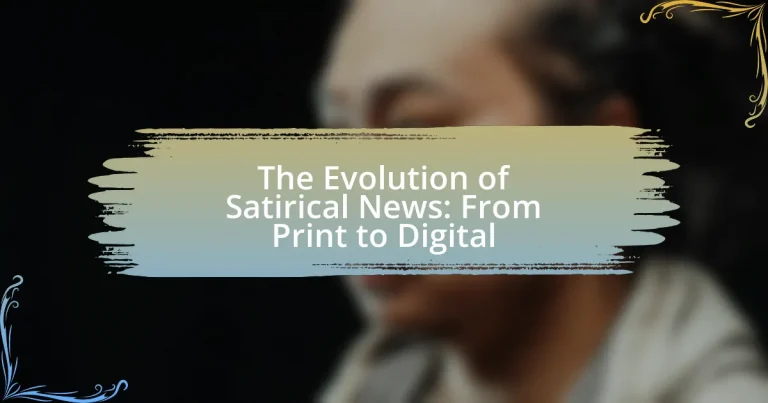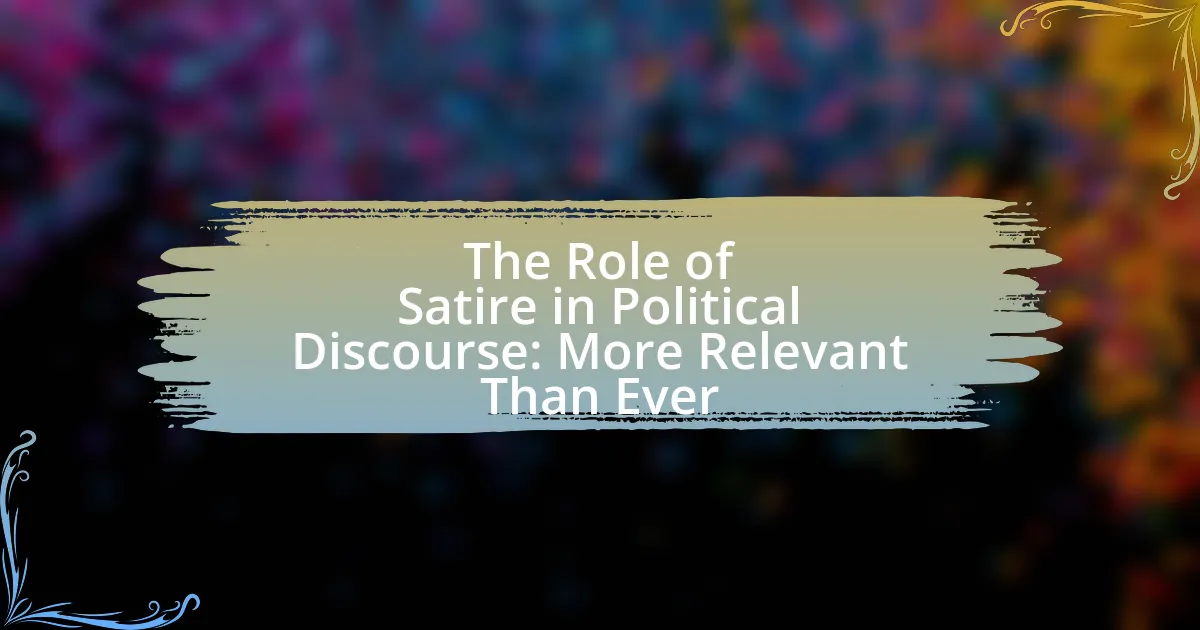The article examines the evolution of satirical news, tracing its origins from 18th-century print media to contemporary digital platforms. It highlights key milestones, including the transition from traditional publications like “The Spectator” to influential television programs such as “Saturday Night Live” and the rise of online satirical outlets like The Onion. The discussion encompasses the impact of technology on audience engagement, the challenges posed by misinformation, and the strategies modern satirical news employs to maintain relevance and credibility in a rapidly changing media landscape. Additionally, it explores the role of satire in political discourse and its influence on public opinion, emphasizing the importance of humor in fostering informed citizenry.
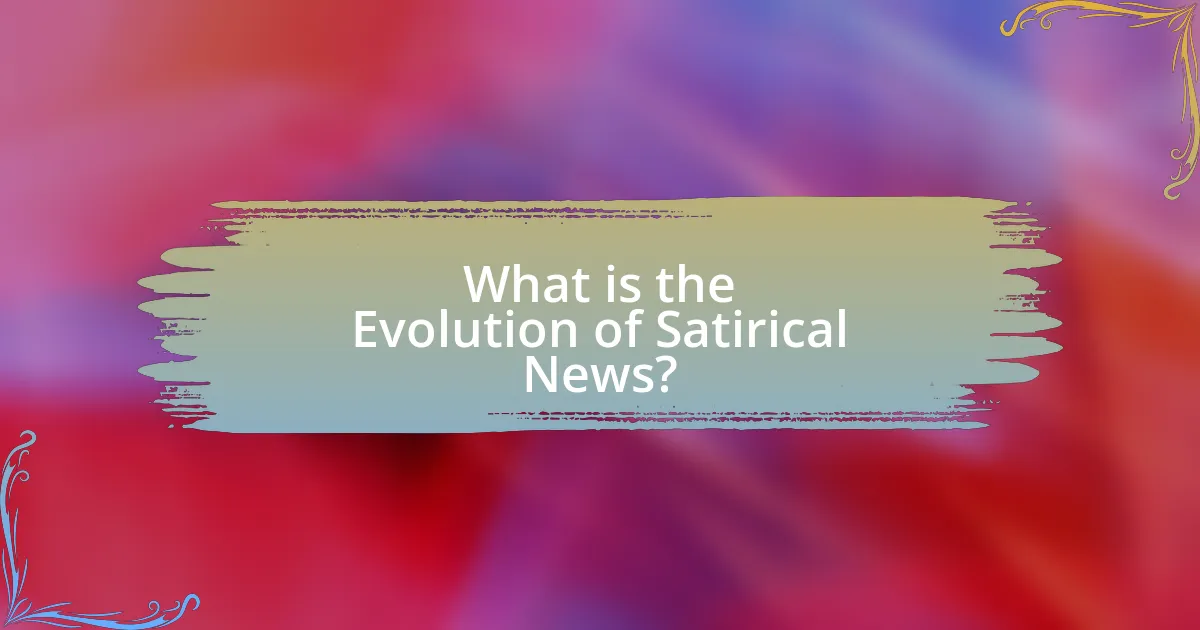
What is the Evolution of Satirical News?
The evolution of satirical news began with print media in the 18th century, exemplified by publications like “The Spectator” and “The Tatler,” which used humor to critique society and politics. As technology advanced, satirical news transitioned to radio and television, with programs such as “Saturday Night Live” and “The Daily Show” emerging in the late 20th century, blending entertainment with political commentary. The rise of the internet in the 21st century further transformed satirical news, leading to the creation of websites like The Onion and satirical social media accounts, which allow for rapid dissemination and engagement with audiences. This shift reflects a broader trend where satire adapts to new platforms while maintaining its core function of social critique.
How has satirical news changed over time?
Satirical news has evolved significantly from traditional print formats to digital platforms, reflecting changes in technology and audience engagement. Initially, satirical news was primarily disseminated through print media, such as newspapers and magazines, with notable examples like “The Onion” and “Punch” using humor to critique societal norms and politics. With the advent of the internet, satirical news transitioned to online platforms, allowing for immediate dissemination and broader reach. This shift enabled real-time commentary on current events, as seen in the rise of social media channels where satirical content can go viral quickly. Furthermore, the integration of multimedia elements, such as videos and memes, has transformed the way satire is consumed, making it more accessible and engaging for diverse audiences. The change from print to digital has also led to a more participatory culture, where audiences can interact with and contribute to satirical content, exemplified by platforms like Twitter and TikTok.
What were the early forms of satirical news in print media?
The early forms of satirical news in print media included pamphlets, broadsheets, and periodicals that utilized humor and irony to critique society and politics. Notable examples are “The Spectator,” published in the early 18th century, which featured satirical essays, and “The Tatler,” which combined news with commentary on social issues. These publications often employed caricatures and exaggerated narratives to mock public figures and prevailing norms, reflecting the political and cultural climate of their time. The use of satire in these formats laid the groundwork for modern satirical journalism, demonstrating the enduring power of humor as a tool for social critique.
How did the rise of television influence satirical news?
The rise of television significantly influenced satirical news by providing a visual medium that enhanced the immediacy and accessibility of satire. Television allowed satirical programs, such as “Saturday Night Live” and “The Daily Show,” to reach wider audiences, utilizing visual humor and real-time commentary on current events. This shift from print to broadcast media enabled satirical news to engage viewers more effectively, as the combination of visuals, sound, and performance created a more impactful experience. The format also encouraged the use of parody and satire to critique political figures and societal issues, making it a powerful tool for public discourse. As a result, television became a dominant platform for satirical news, shaping public perception and influencing political dialogue in ways that print media could not achieve.
Why is satirical news important in society?
Satirical news is important in society because it serves as a critical tool for social commentary and political discourse. By using humor and exaggeration, satirical news highlights societal issues, exposes hypocrisy, and encourages public engagement with current events. For instance, programs like “The Daily Show” and “Saturday Night Live” have historically influenced public opinion and voter behavior, as evidenced by studies showing that viewers of satirical news are more informed about political issues compared to those who consume traditional news sources. This unique blend of entertainment and information fosters a more informed citizenry, making satirical news a vital component of a healthy democracy.
What role does satire play in political discourse?
Satire plays a critical role in political discourse by providing a means to critique and challenge political figures and policies through humor and exaggeration. This form of expression allows audiences to engage with complex political issues in a more accessible manner, often highlighting absurdities and contradictions within political narratives. For instance, satirical programs like “The Daily Show” and “Saturday Night Live” have historically influenced public opinion and increased political awareness by using comedic commentary to address current events. Research indicates that exposure to satirical content can enhance political knowledge and stimulate discussions among viewers, thereby fostering a more informed electorate.
How does satirical news impact public opinion?
Satirical news significantly influences public opinion by shaping perceptions of political and social issues through humor and critique. Research indicates that satirical content can enhance audience engagement and critical thinking, leading to increased awareness of current events. For instance, a study published in the journal “Political Communication” by researchers at the University of Pennsylvania found that exposure to satirical news can lead to greater political knowledge and more informed opinions among viewers. This effect is particularly pronounced among younger audiences who may rely on satirical sources for information, demonstrating that satirical news serves as a powerful tool in framing public discourse and influencing attitudes.
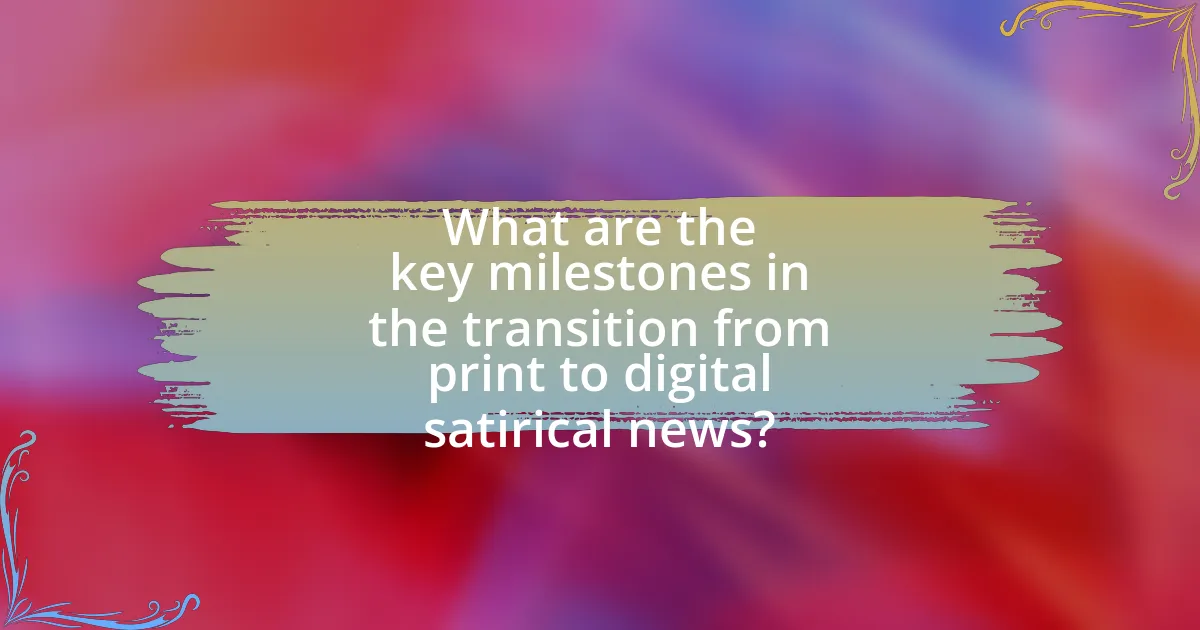
What are the key milestones in the transition from print to digital satirical news?
The key milestones in the transition from print to digital satirical news include the launch of online platforms, the rise of social media, and the adaptation of traditional satirical formats to digital formats. The emergence of websites like The Onion in the late 1990s marked the beginning of dedicated digital satirical news, allowing for immediate publication and wider reach. The proliferation of social media platforms in the 2000s enabled satirical content to be shared virally, significantly increasing audience engagement and interaction. Additionally, established print satirical publications, such as Mad Magazine, began to create digital versions and online content, illustrating the necessity to adapt to changing consumer habits and preferences. These milestones collectively transformed how satirical news is produced, consumed, and disseminated in the digital age.
How did the internet revolutionize satirical news?
The internet revolutionized satirical news by providing a platform for instant dissemination and global reach, allowing satirical content to spread rapidly across diverse audiences. Traditional print media had limitations in distribution and audience engagement, whereas the internet enables satirical news outlets, such as The Onion and Clickhole, to publish content that can be shared virally through social media, reaching millions within minutes. This shift has transformed how satire is consumed and created, with user-generated content and interactive formats becoming prevalent, further enhancing audience participation and engagement in satirical discourse.
What platforms emerged for satirical news online?
Platforms that emerged for satirical news online include The Onion, Clickhole, and The Babylon Bee. The Onion, founded in 1996, is one of the earliest and most recognized satirical news websites, known for its humorous take on current events. Clickhole, launched in 2014 by the creators of The Onion, parodies clickbait websites and viral content. The Babylon Bee, established in 2016, focuses on satirical commentary from a conservative Christian perspective. These platforms have significantly contributed to the landscape of digital satirical news, attracting large audiences and influencing public discourse.
How did social media change the distribution of satirical content?
Social media transformed the distribution of satirical content by enabling rapid sharing and wider reach among audiences. Platforms like Twitter, Facebook, and Instagram allow satirical pieces to be disseminated instantly, reaching millions of users globally, which contrasts sharply with traditional print media that had limited circulation. For instance, a study by the Pew Research Center in 2021 found that 53% of Americans reported getting news from social media, highlighting its role as a primary source for satirical content. This shift has led to increased engagement, as users can interact with and share satirical posts, further amplifying their visibility and impact.
What challenges did satirical news face during this evolution?
Satirical news faced significant challenges during its evolution from print to digital formats, primarily including the struggle for credibility and the proliferation of misinformation. As satirical news transitioned online, it encountered skepticism from audiences who often conflated satire with genuine news, leading to misunderstandings about its intent. Additionally, the rise of social media platforms facilitated the rapid spread of false information, making it difficult for satirical content to be recognized as humor rather than fact. This confusion was exacerbated by studies indicating that a substantial portion of the public could not distinguish between satire and real news, as highlighted in research by the Pew Research Center, which found that 64% of Americans believed that satirical news could mislead people.
How did the rise of misinformation affect satirical news?
The rise of misinformation has significantly impacted satirical news by blurring the lines between fact and fiction. As misinformation proliferated, audiences increasingly struggled to differentiate between genuine news and satire, leading to confusion and misinterpretation of satirical content. For instance, studies have shown that satirical news outlets, like The Onion and The Babylon Bee, have seen their content taken literally by some readers, which undermines the intended humor and critique. This phenomenon has prompted satirical news creators to adapt their strategies, often incorporating clearer cues or disclaimers to signal their content’s fictional nature, thereby attempting to maintain their relevance and effectiveness in a landscape saturated with misleading information.
What legal issues have arisen for satirical news in the digital age?
Legal issues for satirical news in the digital age primarily include defamation, copyright infringement, and the challenge of distinguishing between satire and misinformation. Defamation claims have increased as public figures and organizations seek to protect their reputations against potentially harmful satirical content. For instance, the case of Hustler Magazine v. Falwell established that public figures must prove actual malice to win defamation suits, which remains a critical precedent for satirical news. Copyright infringement arises when satirical news outlets use copyrighted material without permission, leading to legal disputes over fair use. Additionally, the rise of social media complicates the landscape, as platforms may inadvertently spread misinformation, blurring the lines between satire and factual reporting, which can lead to legal repercussions for the creators.
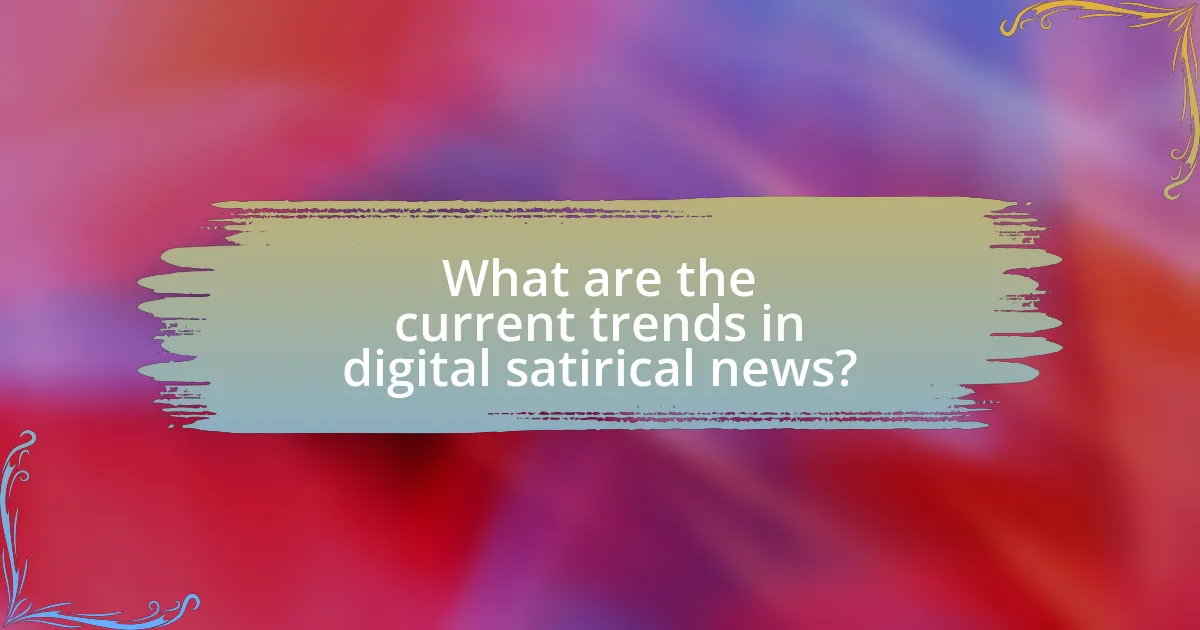
What are the current trends in digital satirical news?
Current trends in digital satirical news include the rise of social media platforms as primary distribution channels, the use of video content for greater engagement, and the blending of satire with real-time news reporting. Social media, particularly platforms like Twitter and TikTok, allows satirical news outlets to reach wider audiences quickly, often capitalizing on trending topics. Video content, such as short skits or animated segments, has become increasingly popular, as it caters to the consumption habits of younger audiences who prefer visual media. Additionally, many satirical news organizations are integrating real-time news elements into their content, providing commentary on current events while maintaining a humorous perspective, which enhances their relevance and appeal. These trends reflect the evolving landscape of media consumption and the ongoing demand for humor in the face of serious news.
How are modern satirical news outlets adapting to digital platforms?
Modern satirical news outlets are adapting to digital platforms by leveraging social media, video content, and interactive formats to engage audiences. These outlets, such as The Onion and The Babylon Bee, utilize platforms like Twitter, Facebook, and YouTube to distribute their content rapidly and reach a broader audience. For instance, The Onion has successfully integrated short video clips and memes into its strategy, capitalizing on the viral nature of these formats to enhance visibility and shareability. Additionally, they often employ audience interaction through comments and polls, fostering a community around their content. This shift reflects a broader trend in media consumption, where digital engagement is paramount, as evidenced by the significant increase in online viewership and social media shares for satirical content in recent years.
What innovative formats are being used in digital satire?
Digital satire employs innovative formats such as video sketches, memes, podcasts, and interactive web content. These formats leverage the rapid dissemination capabilities of the internet and social media platforms, allowing creators to engage audiences in unique ways. For instance, video sketches often parody current events with humor, while memes condense complex ideas into easily shareable images, enhancing relatability and virality. Podcasts provide a platform for in-depth satirical commentary, allowing for nuanced discussions that resonate with listeners. Interactive web content, such as satirical quizzes or games, invites user participation, further immersing audiences in the satire. These formats reflect the adaptability of satire in the digital age, catering to diverse audience preferences and consumption habits.
How do audience engagement strategies differ in digital satirical news?
Audience engagement strategies in digital satirical news differ significantly from traditional formats by leveraging interactive elements and real-time feedback mechanisms. Digital platforms enable satirical news outlets to utilize social media for immediate audience interaction, allowing for comments, shares, and reactions that can shape content in real-time. For instance, platforms like Twitter and Facebook facilitate direct engagement through polls, memes, and user-generated content, which enhances audience participation and fosters a community around the satire. This contrasts with print media, where audience engagement is typically limited to letters to the editor or delayed feedback. The immediacy and interactivity of digital platforms have been shown to increase audience retention and loyalty, as evidenced by studies indicating that satirical content shared on social media garners higher engagement rates compared to traditional news articles.
What impact does digital satirical news have on traditional media?
Digital satirical news significantly influences traditional media by reshaping audience engagement and altering news consumption patterns. This impact is evident as digital satirical platforms attract younger audiences who prefer humor and critique over conventional reporting, leading traditional media to adapt their content strategies. For instance, studies show that platforms like The Onion and The Daily Show have increased public interest in political issues, prompting traditional outlets to incorporate more satire and commentary in their reporting to retain viewership. This shift not only diversifies the media landscape but also challenges traditional media’s credibility, as audiences often question the accuracy of serious news in light of satirical interpretations.
How is traditional journalism responding to the rise of digital satire?
Traditional journalism is adapting to the rise of digital satire by incorporating elements of humor and satire into its reporting to engage audiences. This shift is evident as news organizations recognize that satirical content can attract viewers and enhance storytelling. For instance, major outlets like The New York Times and The Washington Post have launched satirical sections or collaborated with satirical platforms, acknowledging that humor can effectively address serious topics and resonate with younger audiences. This response reflects a broader trend where traditional media seeks to remain relevant in a landscape increasingly dominated by digital satire, which often garners significant social media traction and audience engagement.
What lessons can traditional media learn from digital satirical news?
Traditional media can learn the importance of engaging storytelling and audience interaction from digital satirical news. Digital satirical platforms often utilize humor and relatable content to capture attention, which can enhance audience retention and shareability. For instance, platforms like The Onion and The Babylon Bee effectively use satire to comment on current events, making complex issues more accessible and entertaining. This approach not only attracts a wider audience but also encourages social media sharing, as evidenced by The Onion’s millions of followers across various platforms. By adopting similar strategies, traditional media can improve its relevance and connection with younger audiences, who increasingly prefer content that is both informative and entertaining.
What best practices can be applied to create effective satirical news content?
To create effective satirical news content, writers should focus on clarity, relevance, and humor that resonates with current events. Clarity ensures that the satire is easily understood, allowing the audience to grasp the underlying message quickly. Relevance ties the satire to contemporary issues, making it relatable and engaging for readers. Humor should be sharp and insightful, often employing exaggeration or irony to highlight absurdities in real-world situations. For instance, successful satirical platforms like The Onion and The Babylon Bee utilize these practices by crafting headlines that reflect current news while infusing them with wit, thereby enhancing their impact and shareability.
How can satirical news maintain credibility while entertaining?
Satirical news can maintain credibility while entertaining by grounding its humor in factual events and using clear disclaimers about its fictional nature. This approach allows satirical outlets to engage audiences with humor while ensuring that the underlying truths are recognizable, which helps prevent misinformation. For instance, shows like “The Daily Show” and “Last Week Tonight” often base their satire on real news stories, providing context and factual references that reinforce their commentary. By doing so, they create a balance between entertainment and informative content, allowing viewers to discern the truth behind the satire.
What strategies can enhance audience reach and engagement in satirical news?
Utilizing social media platforms effectively enhances audience reach and engagement in satirical news. By leveraging platforms like Twitter, Facebook, and Instagram, satirical news outlets can share content rapidly, engage with audiences through comments and shares, and utilize trending hashtags to increase visibility. Research indicates that satirical content shared on social media can achieve higher engagement rates, with studies showing that humorous posts are more likely to be shared, thus expanding reach. For instance, a study by the Pew Research Center found that 62% of adults get news from social media, highlighting the importance of these platforms in disseminating satirical news.
